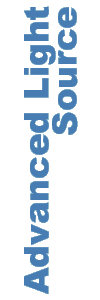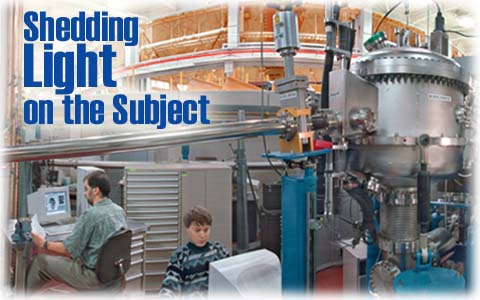
 |
 |
 Photons, the bullet-like pulses of energy that make up light, are the detectives of science. Unleash the right squad to investigate the surface of a material, the structure of a crystal, or the scene of some chemical activity and it will tell you which atoms and molecules were present, how many of each were there, and what each one did. The right squad of detectives means photons at specific wavelengths and energies along the electromagnetic spectrum. When it comes to investigative work, some of the most versatile detectives are photons that fall in the region of the spectrum between high-energy or "extreme" ultraviolet light and low energy or "soft" x-rays. And when it comes to producing those types of photons for scientific investigations, Berkeley Lab's Advanced Light Source (ALS) is among the best in the world. In an historic workshop this past spring, more than 300 international scientific leaders in synchrotron radiation came to Berkeley Lab to discuss use of the ALS in such areas as biosciences, materials, and environmental studies. At the workshop's conclusion, it was the attendees' consensus that the ALS is a powerful national resource for performing research to advance the forefronts of their disciplines. ALS Director Daniel Chemla believes the key to the Light Source's success is to foster a world-class scientific program—through close partnerships with ALS users and by developing the vast potential of the facility itself. Neville Smith, Deputy for the ALS scientific programs, agrees. "It is the quality of science produced that is the true measure of a user facility's success," Smith says. The central feature of the ALS is an electron synchrotron, a machine that accelerates electrons around a circular path. The ALS synchrotron is designed to accelerate electrons to energies of 1.5 billion electron volts (GeV) at "relativistic speeds"—meaning close to the 186,282 miles per second speed of light. At that peak energy and speed, electrons travelling along a curved path give off XUV photons. After light is extracted from the ALS storage ring it is sent through beamlines, branched off and directed into experimental stations by means of special mirrors and optical devices. It is here in these experimental stations where science at the ALS takes place. Having been designated by the U.S. Department of Energy as a national user facility, the ALS is available for research by qualified scientists and engineers from anywhere in the United States or around the world. Dedicated in October, 1993, today the facility serves more than 600 researchers. The following stories highlight some of their recent accomplishments, and reveal the cutting-edge nature of the science being performed at the ALS. |
|
|